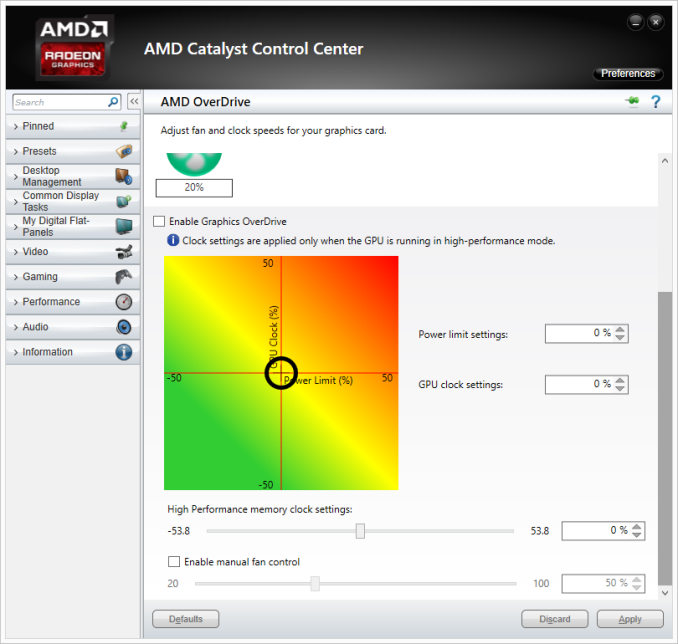Sapphire Radeon R9 290 Tri-X OC Review: Our First Custom Cooled 290
by Ryan Smith on December 24, 2013 3:45 PM EST- Posted in
- GPUs
- AMD
- Radeon
- Sapphire
- Radeon 200
290 Tri-X OC Thermal Management
Before jumping into our benchmarks, due to the significant focus we’re placing on cooling and noise for the 290 Tri-X OC (amidst the reference 290’s weaknesses) we also wanted to spend a moment discussing the card’s thermal management algorithms.
With the 290 series AMD introduced their next generation PowerTune technology, which allows for thermal management based on temperatures, power consumption, and now fan speeds. For the reference 290X in particular this was especially important as AMD used this functionality to keep fan speed noises in check despite the heavy thermal load Hawaii placed on the cooler. At the time we had assumed that everyone would use this technology even if they used different coolers, but as it turns out this isn’t the case.
For the 290 Tri-X OC Sapphire has reverted to traditional power and temperature based throttling, opting not to use the functionality of next generation PowerTune. This means that the 290 Tri-X OC does not offer the ability to throttle based on fan speeds, nor does it offer the ability to adjust the temperature it throttles at, instead throttling at Hawaii’s TjMax. This implementation caught us off guard at first since we had expected everyone to use next generation PowerTune, however as it turns out this is something that board partners get to decide for themselves on their customized cards.
Sapphire for their part has told us that based on the ample cooling performance of the Tri-X cooler that they've opted to use a traditional thermal management implementation in order to better sustain performance. Though we can’t readily test Sapphire’s statements about sustainability, we certainly can’t argue against Sapphire’s statement on the performance of their cooler. We’ll see the full breakdown in our benchmark section, but they are having absolutely no problem balancing noise and temperatures right now without next generation PowerTune.
Realistically we wouldn’t be surprised if this was also chosen because the Tri-X cooler predates the 290 series – and hence it wasn’t necessarily designed to work well with next generation PowerTune – but that’s just speculation on our part. To that end it would have been interesting to see a full next generation PowerTune implementation on this card, however it’s really just an intellectual curiosity. Out of the box the 290 Tri-X OC works just fine with a traditional thermal management implementation.
The Test
| CPU: | Intel Core i7-4960X @ 4.2GHz |
| Motherboard: | ASRock Fatal1ty X79 Professional |
| Power Supply: | Corsair AX1200i |
| Hard Disk: | Samsung SSD 840 EVO (750GB) |
| Memory: | G.Skill RipjawZ DDR3-1866 4 x 8GB (9-10-9-26) |
| Case: | NZXT Phantom 630 Windowed Edition |
| Monitor: | Asus PQ321 |
| Video Cards: |
AMD Radeon R9 290X AMD Radeon R9 290 XFX Radeon R9 280X Double Dissipation Asus Radeon R9 280X DirectCU II TOP Sapphire Radeon R9 280X Toxic AMD Radeon HD 7970 GHz Edition AMD Radeon HD 7970 NVIDIA GeForce GTX 770 NVIDIA GeForce GTX 780 NVIDIA GeForce GTX 780 Ti |
| Video Drivers: |
NVIDIA Release 331.93 AMD Catalyst 13.11 Beta v8 AMD Catalyst 13.11 Beta v9.5 |
| OS: | Windows 8.1 Pro |











119 Comments
View All Comments
teiva - Thursday, January 2, 2014 - link
The prices in Australia haven't fluctuated and stayed pretty well the same since their introduction.Mopar63 - Thursday, January 2, 2014 - link
Brent20 this shows a lack of understand of how things work. AMD is not catering to miners. The particular way the mining software works just happens to work better on AMD's GPU design than on NVidia. This was not done with miners in mind it was the design they chose BEFORE anyone knew miners existed.If they put anything in the "block" miners that would just be wrong. AMD sells APUs, they do not care who buys them, only that some one buys them, NVidia does this the same way. Blocking a potential user is bad business and in this case may hurt the GPU in other areas of performance.
FookDuSushi - Monday, January 6, 2014 - link
If they already have a ready one's why don't they release it to the public yet??capawesome9870 - Saturday, January 11, 2014 - link
do you have any 4k tests? similar to the Low-Medium on the original R9 290 and 290x reviews.boozzer - Wednesday, January 22, 2014 - link
will there is a 290x version? this seems to be the cooler to get. please, please do a 290x tri x oc review + oc review!!!!!!!!!!! please.Muckster - Friday, February 28, 2014 - link
How would this card compare to the MSI GTX 780 ti in terms of noise and temp? Techpowerup has an article on the GTX but I can't seem to find an apples to apples comparison. As with the Sapphire to the stock R9 290, the MSI improved significantly on the noise level of the stock GTX 789 ti.http://www.techpowerup.com/reviews/MSI/GTX_780_Ti_...
kiddo - Monday, March 3, 2014 - link
is this good ? cause my bro bought it for me, I`m 5yr :3P39Airacobra - Tuesday, January 13, 2015 - link
over 500watts? That must be a error! The dam thing has a 275watt TDP, So at the most it should only go a litte past 400 watts maybe but that's it!driessen9 - Friday, March 6, 2015 - link
what program did you use for the overclocking?